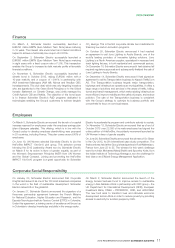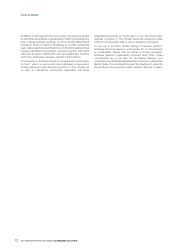APC 2015 Annual Report Download - page 22
Download and view the complete annual report
Please find page 22 of the 2015 APC annual report below. You can navigate through the pages in the report by either clicking on the pages listed below, or by using the keyword search tool below to find specific information within the annual report.
2015 REGISTRATION DOCUMENT SCHNEIDER ELECTRIC20
OVERVIEW OF THE GROUP’S STRATEGY, MARKETS AND BUSINESSES
1BUSINESSES, END-MARKETS ANDCUSTOMER CHANNELS
2.2 Serving four attractive end markets
Schneider Electric serves customers in four principal markets:
•Non-residential & R esidential Buildings;
•Utilities and Infrastructures;
•Industries and Machine M anufacturers;
•Data Centers and Networks.
Non-residential and residential buildings
The non-residential buildings market includes public, commercial
and industrial buildings such as offi ces, hotels, hospitals, shopping
malls , schools, sports and cultural centers. Because this sector is
energy intensive, energy effi ciency is key and is subject to new and
demanding regulations. Specifi c requirements have to be met in
terms of occupant comfort, safety and environmental friendliness,
as do the needs of owners and building managers seeking to
reduce investment costs and optimize maintenance and operating
costs. Schneider Electric’s non-residential customers include end-
users, property developers, design fi rms, systems integrators,
panel builders and installers, electrical equipment distributors and
building management companies.
In the context of single-family homes and apartment buildings,
Schneider Electric’s market is driven both by renovation and
refurbishment needs, particularly in mature economies, as well as by
construction, particularly in new economies. Whether for renovation
or construction, the underlying challenge is to reconcile technical
constraints, local standards and regulations with consumer
preferences. They not only desire comfort and aesthetics, but
increasingly, energy effi ciency, connectivity, security and monitoring
services as well. Residential customers include mainly electricians,
architects and decorators, those involved in the home automation
industry, lighting and security fi rms, construction fi rms, contractors,
electrical equipment distributors and large do-it-yourself (“ DIY” )
stores, as well as end-users and home owners.
Utilities and infrastructures
Current global challenges in the utilities and infrastructure market
include increasing energy demand, the need for increased energy
effi ciency to reduce environmental impact, and the development
of renewable energy sources on the grid causing more stability
concerns. This market also faces changes in regulations, particularly
those regarding demand response, and the growing need for
security, reliability, and real-time control to ensure effi ciency &
stability. We believe these challenges provide long-term growth
prospects for Schneider Electric . Our main customers in this market
include energy operators, water utilities, the owners and operators
of transportation and oil & gas infrastructure and municipalities.
Industries and machine manufacturers
Our energy solutions enable us to serve almost all segments
of the industries and machine manufacturers market, including
mines, cement plants, the food-processing industry and material
handling and packaging machines. With Invensys, we have
reinforced our presence in the r efi ning, p etrochemical and o il &
g as i ndustries. Energy effi ciency is at the heart of the challenges
facing these industries, which include the reduction of production
costs, compliance with new regulations, and the reduction of the
environmental impact of industrial activity. In addition, both the rapid
industrialization taking place in new economies and the need to
modernize existing industrial facilities in mature economies create
signifi cant opportunities for growth. Our customers include end
users and professional intermediaries, engineering fi rms, systems
integrators, OEMs, electro-intensive industries, panel builders and
electrical distributors.
Data centers and networks
Data centers are secure, precision-cooled sites containing
Information Technology (IT) equipment that processes and
storesvery large quantities of digital data.These sites are the nerve
centers of businesses and the public sector. The expansion of data
centers requires a signifi cant increase in electricity to accommodate
the IT equipment’s operation and cooling, as the amount of energy
needed to cool these rooms has become comparable to the
amount of energy needed to operate the equipment itself.
Schneider Electric believes that data centers and networks are a
high-potential market due to the growing digitalization of professional
and personal activities. With the development of internet giants
and cloud computing, the physical infrastructure of data centers
tends to be increasingly the business of dedicated players with high
performance expectations.
























